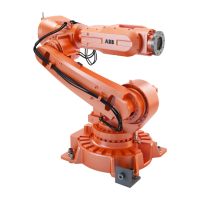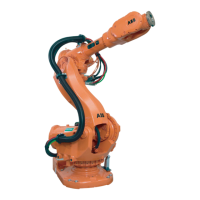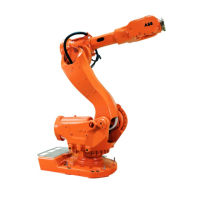Description
Product Specification IRB 6600 M2000 7
The ABS is active during all stop modes, braking the robot to a stop with the power of
the servo drive system along the programmed path. After a specific time the mechanical
brakes are activated ensuring a safe stop even in case of a failure of the drive system or
a power interruption.
The maximal applicable torque on the most loaded axis determines the stopping
distance.
The stopping process is in accordance with a class 1 stop.
While programming the robot in manual mode a class 0 stop, with mechanical brakes
only, applies.
The Self Tuning Performance (STP)
The Process Robot Generation is designed to run at different load configurations, many
of which occur within the same program and cycle.
The robot’s installed electrical power can thus be exploited to lift heavy loads, create a
high axis force or accelerate quickly without changing the configuration of the robot.
Consequently the robot can run in a “power mode” or a “speed mode” which can be
measured in the respective cycle time of one and the same program but with different
tool loads. This feature is based on QuickMove
TM
.
The respective change in cycle time can be measured by running the robot in NoMotion-
Execution with different loads or with simulation tools like RobotStudio.
The Electronically Stabilised Path (ESP)
The load and inertia of the tool have a significant effect on the path performance of a
robot. The Process Robot Generation is equipped with a system to electronically
stabilise the robot’s path in order to achieve the best path performance.
This has an influence while accelerating and braking and consequently stabilises the
path during all motion operations with a compromise of the best cycle time. This feature
is secured through TrueMove
TM
.
Over-speed protection
The speed of the robot is monitored by two independent computers.
Restricting the working space
The movement of each axis can be restricted using software limits.
As options there are safeguarded space stops for connection of position switches to
restrict the working space for the axes 1-3.
Axes 1-3 can also be restricted by means of mechanical stops.
Collision detection (option)
In case an unexpected mechanical disturbance occurs, like a collision, electrode stick-
ing, etc., the robot will detect the collision, stop on the path and slightly back off from
its stop position, releasing tension in the tool.
The Passive Safety System
The Process Robot Generation has a dedicated passive safety system that by hardware
construction and dedicated solutions is designed to avoid collisions with surrounding
equipment. It integrates the robot system into the surrounding equipment safely.
Compact robot arm design
The shape of the lower and upper arm system is compact, avoiding interference into the
working envelope of the robot.

